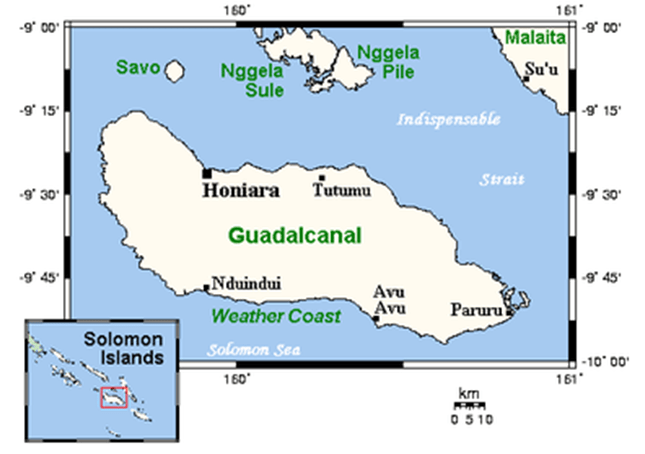Guadalcanal

Guadalcanal (/ˌɡwɑːdəlkəˈnæl/; indigenous name: Isatabu) is the principal island in Guadalcanal Province of the Solomon Islands, located in the south-western Pacific, northeast of Australia. It is the largest island in the Solomon Islands by area, and the second by population (after Malaita). The island is mainly covered in dense tropical rainforest and has a mountainous interior.
Honiara is the largest city of Guadalcanal and the capital of Solomon Islands
Guadalcanal’s discovery by westerners was under the Spanish expedition of Álvaro de Mendaña in 1568. The name comes from the village of Guadalcanal, in the province of Seville, in Andalusia, Spain, birthplace of Pedro de Ortega Valencia, a member of Mendaña’s expedition.
During 1942–43, it was the scene of the Guadalcanal Campaign and saw bitter fighting between Japanese and US troops. The Americans were ultimately victorious. At the end of World War II, Honiara, on the north coast of Guadalcanal, became the new capital of the British Solomon Islands Protectorate.
The island has been settled since at least 4500-2500 BC based on archaeological finds at Poha Cave and Vatuluma Posovi. During the period 1200-800 BC Austronesian Lapita peoples settled the islands.
A Spanish expedition from Peru in 1568 under the command of Álvaro de Mendaña de Neira were the first Europeans to see the island. Mendaña’s subordinate, Pedro de Ortega Valencia, named the island after his home town Guadalcanal in Andalusia, Spain.[3] The name comes from the Arabic Wādī l-Khānāt (وادي الخانات), which means “Valley of the Stalls” or “River of Stalls”, referring to the refreshment stalls which were set up there during Muslim rule in Andalusia. In the years that followed the discovery, the island was variously referred to as Guadarcana, Guarcana, Guadalcana, and Guadalcanar, which reflected different pronunciations of its name in Andalusian Spanish.
European settlers, whalers, and missionaries began to arrive in the 18th and 19th centuries. With these outsiders also arrived foreign institutions like the slave trade. Beginning since the 1860s, about 60,000 natives from Guadalcanal and other parts of Solomon were enslaved and sent to Australia or Fiji to work on plantations. The local slave trade would not cease until the 1890s. In the 1880s, the Germans and the British vied for control of the Solomons.
Germany established a protectorate over the northern Solomons in 1884 while in the year 1893, the British Solomon Islands Protectorate was proclaimed which included the island of Guadalcanal. However, Germany eventually gave most of their protectorate to Britain in 1899. By the early 20th century, large agricultural plantations (specializing in copra) run mainly by Australians were established in the region. Guadalcanal was not seriously impacted by World War I. In 1932, the British confirmed the name Guadalcanal in line with the town in Andalusia, Spain.
